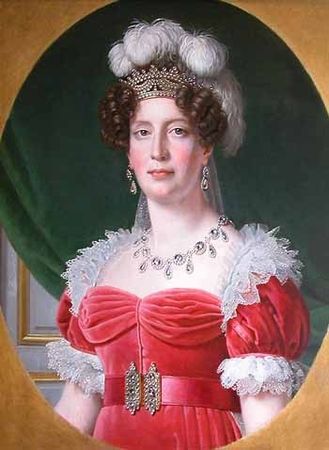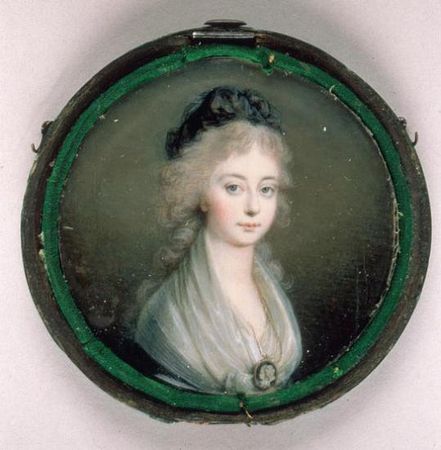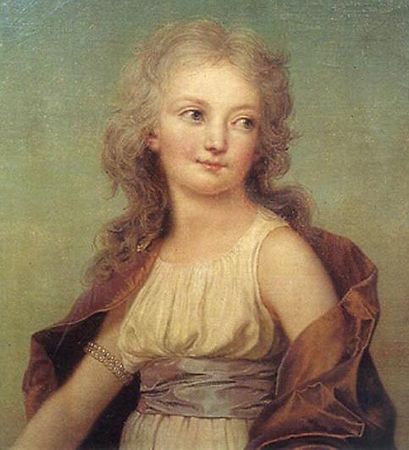Whatever happened to Marie Therese of France?
 Have you ever wondered what happened to Marie Antoinette's children? I was thinking about it the other day when I found a book, quite by chance, about her daughter Marie Therese (otherwise known as Charlotte) in a second hand book shop. Ten-year old Louis, her brother and Dauphin, was murdered in prison...he was battered and beaten, tortured to accuse his mother of incest and eventually died of tuberculosis. Marie Therese, however, survived the Revolution and lived to the ripe old age of 72. She had an unhappy, non-consummated and thus childless marriage to the Duke of Angoulême and was buried in Slovakia beside her uncle and her husband.
Have you ever wondered what happened to Marie Antoinette's children? I was thinking about it the other day when I found a book, quite by chance, about her daughter Marie Therese (otherwise known as Charlotte) in a second hand book shop. Ten-year old Louis, her brother and Dauphin, was murdered in prison...he was battered and beaten, tortured to accuse his mother of incest and eventually died of tuberculosis. Marie Therese, however, survived the Revolution and lived to the ripe old age of 72. She had an unhappy, non-consummated and thus childless marriage to the Duke of Angoulême and was buried in Slovakia beside her uncle and her husband.
Here is the story of Marie Therese of France with a lot of help from Wikipedia:
Marie-Thérèse was never told what had happened to her family whilst she remained prisoner in the tower. All she knew was that her father was dead, and she had no news at all from her beloved mother whom she missed and feared for desperately. Her aunt Elisabeth (Louis XVI younger sister) with whom she had shared her captivity had been wrenched from her and executed, leaving her entirely alone. The following words were scratched on the wall of her room in the tower:
Marie-Thérèse is the most unhappy creature in the world. She can obtain no news of her mother; nor be reunited to her, though she has asked it a thousand times. Live, my good mother! whom I love well, but of whom I can hear no tidings. O my father! watch over me from heaven above, life was so cruel to her. O my God! forgive those who have made my family die."
On 11 May, Robespierre is reported to have visited Marie-Thérèse in prison although there is no written record of their conversation. It was only after the Reign of Terror that Marie-Thérèse was allowed to leave France. She was liberated on 18 December 1795, on the eve of her seventeenth birthday, and taken to Vienna, the capital city of her cousin, the Holy Roman Emperor Francis II, also her mother's birthplace.
 Marie-Thérèse later moved to Mitau, Courland (now Jelgava, Latvia), where her father's eldest surviving brother, the comte de Provence, lived as a guest of Tsar Paul I of Russia. He had proclaimed himself King of France as Louis XVIII after the death of Marie-Thérèse's brother. With no children of his own, he wished his niece to marry Louis-Antoine, duc d'Angoulême, his nephew and her cousin, who would be the eventual dynastic heir to the throne of France. Marie-Thérèse agreed unquestioningly, happy only to be part of a family again.
Marie-Thérèse later moved to Mitau, Courland (now Jelgava, Latvia), where her father's eldest surviving brother, the comte de Provence, lived as a guest of Tsar Paul I of Russia. He had proclaimed himself King of France as Louis XVIII after the death of Marie-Thérèse's brother. With no children of his own, he wished his niece to marry Louis-Antoine, duc d'Angoulême, his nephew and her cousin, who would be the eventual dynastic heir to the throne of France. Marie-Thérèse agreed unquestioningly, happy only to be part of a family again.
Louis-Antoine was a shy, stammering young man. His father, the comte d'Artois, who viewed his eldest son as a crass embarrassment, tried to persuade Louis XVIII against the marriage. The wedding, however, went ahead in 1799. It took place in Jelgava Palace (modern-day Latvia).
The royal family moved to the UK and settled at Hartwell House, Buckinghamshire. Marie-Thérèse's father-in-law, the comte d'Artois, spent most of his time in Edinburgh, where he had been given apartments at Holyrood House. The long years of exile ended with the abdication of Napoleon I in 1814, and the first Bourbon Restoration, when Louis XVIII took the throne of France, twenty-one years after the death of his brother Louis XVI.
In March 1815, Napoléon returned to France and rapidly began to gain supporters, raising an army in the period known as the One Hundred Days. Louis XVIII fled France, but Marie-Thérèse, who was in Bordeaux at the time, attempted to rally the local troops. They agreed to defend her but not to cause a civil war with Napoléon. Marie-Thérèse stayed in Bordeaux despite Napoléon's orders to have her arrested. Believing her cause to be lost, and to spare Bordeaux senseless destruction, she finally agreed to leave. Her actions caused Napoléon to remark that she was the "only man in her family".
Louis XVIII died on 16 September 1824, and was succeeded by his younger brother, the comte d'Artois, as Charles X. Marie-Thérèse's husband was now heir to the throne, and she was addressed as Madame la Dauphine. However, anti-monarchist feeling was on the rise again. Charles's ultra-royalist sympathies alienated many members of the working and middle classes.
On 2 August 1830, after Les Trois Glorieuses, the Revolution of July 1830 which lasted three days, Charles X, who with his family had gone to château de Rambouillet, abdicated in favor of his son, who abdicated in favor of his nephew, the Duke de Bordeaux '(I do hope you're following!). In spite of the fact that Charles X had asked him to be regent for the young king, Louis-Philippe, the Duke accepted the crown when the Chambre des Députés named him King of the French.
On 4 August, in a long cortège, Marie-Thérèse left Rambouillet for a new exile with her uncle, her husband, her young nephew and other family members and, on 16 August, reached the port of Cherbourg where they boarded a ship for Britain (again - I guess they liked the great cuisine).
 The royal family lived in what was then 21-22 Regent Terrace in Edinburgh until 1833 when the former king chose to move to Prague as a guest of Marie-Thérèse's cousin, the Emperor Francis II of Austria. They moved into the luxurious Schloss-Hradschin. Later, the royal family left Prague and moved to the estate of Count Coronini near Gorizia, Italy. Marie-Thérèse devotedly nursed her uncle through his last illness there in 1836, when he died of cholera.
The royal family lived in what was then 21-22 Regent Terrace in Edinburgh until 1833 when the former king chose to move to Prague as a guest of Marie-Thérèse's cousin, the Emperor Francis II of Austria. They moved into the luxurious Schloss-Hradschin. Later, the royal family left Prague and moved to the estate of Count Coronini near Gorizia, Italy. Marie-Thérèse devotedly nursed her uncle through his last illness there in 1836, when he died of cholera.
Her husband died in 1844. Marie-Thérèse then moved to Schloss Frohsdorf, a baroque castle just outside of Vienna. In 1848, after Louis-Philippe's reign ended in another revolution, France again became a republic.
Marie-Thérèse died of pneumonia on 19 October 1851, three days after the fifty-eighth anniversary of the execution of her mother, Marie Antoinette. She was buried next to her uncle Charles X and her husband Louis XIX, in the crypt of the Franciscan Monastery church of Kostanjevica in Görtz, then in Austria, now the Slovenian city of Nova Gorica.
What a life, how movemented...I wonder how her life would have been had her family been able to escape rather than captured at Varennes so many years before? Poor Marie Therese. So profoundly scarred was she by the murder of her parents, brother and aunt that she lived a bitter existence, incapable of loving despite her hunger to belong to a family and be a mother herself.
So, now you know.

/https%3A%2F%2Fstorage.canalblog.com%2F33%2F16%2F508287%2F95344135_o.jpg)
/https%3A%2F%2Fstorage.canalblog.com%2F52%2F26%2F508287%2F95342137_o.jpg)
/https%3A%2F%2Fstorage.canalblog.com%2F42%2F99%2F508287%2F95342518_o.jpg)
/https%3A%2F%2Fstorage.canalblog.com%2F97%2F52%2F508287%2F55786848_o.jpg)
/https%3A%2F%2Fstorage.canalblog.com%2F33%2F68%2F508287%2F55786597_o.jpg)
/https%3A%2F%2Fstorage.canalblog.com%2F40%2F91%2F508287%2F98712362_o.jpg)
/https%3A%2F%2Fstorage.canalblog.com%2F38%2F76%2F508287%2F83379594_o.jpg)
/https%3A%2F%2Fstorage.canalblog.com%2F06%2F96%2F508287%2F83377251_o.jpg)
/https%3A%2F%2Fstorage.canalblog.com%2F92%2F69%2F508287%2F69301410_o.jpg)